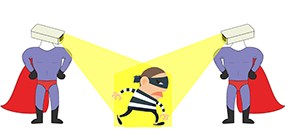|
A common misunderstanding in today’s security world is that video analytics is restricted to fixed cameras, when in fact; the ability to utilize video analytics on in-motion pan-tilt-zoom (PTZ) cameras has been available for many years. It is not until recently, however, that the capability to perform video detection while a PTZ camera is in full motion has become more readily available to security integrators and dealers. This capability, also referred to as motion detection while scanning, has been slow to commercialization partly due to the complexity of the solution, and the limited number of manufacturers that have addressed the technical hurdles. Today, there are several commercially viable solutions on the market, opening a new era of automated video surveillance and detection. Video Analytics is the ability to analyze a live or recorded video feed and intelligently extract useful data concerning what is happening in the scene. This is a widely used capability for the protection of critical facilities and assets. Types of video analytics vary greatly, from simple detection, object classification, counting, monitoring for removed objects to loitering detection. The ability to utilize these algorithms to automatically provide insight to security personnel has proven to be a valuable tool. Although there are many types of video analytics available, most algorithms used in today’s security environment have been limited to fixed cameras and fixed scenes. This is unfortunate for security personnel as the PTZ camera continues to remain one of the most powerful tools in the security arsenal. This is partly due to the camera’s ability to point in any direction and at many zoom levels, allowing the security person to cover a large area without the need for many additional fixed sensors. This is an important capability, as a vast amount of any facility is typically not covered with full time video surveillance. This continued reliance on the PTZ camera has driven an increased demand to utilize video analytics on in-motion PTZ cameras. Although many different solutions are available, in-motion video analytics remain a complex task with several technical hurdles. Understanding Frame of Reference: At its most basic premise, detection using video analytics is about understanding changes in pixels. However, to avoid alarming on pixel changes due to lighting, shadows or falling leaves, video analytic algorithms need to understand some details of the scene. Understanding that a pixel, or several pixels, represents a very small object (a leaf) or a large object (a vehicle), is critical to understanding what is a real item of interest, versus nuisance motion. Knowledge of the horizon, or geospatial data, is also extremely useful. The amount of scene information required varies greatly over the spectrum of video analytic solutions, but in all cases, some details of the scene must be communicated to the algorithm during setup. 원본링크 : http://www.puretechsystems.com/blog/using-video-analytics-with-pan-tilt-zoom-cameras/
0 Comments
Leave a Reply. |
AxxonsoftKorea office Archives
June 2021
Categories |


 RSS Feed
RSS Feed